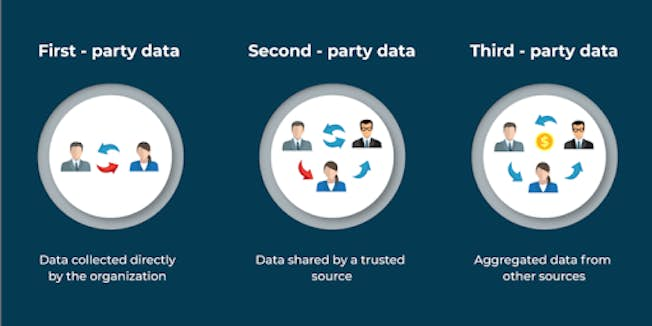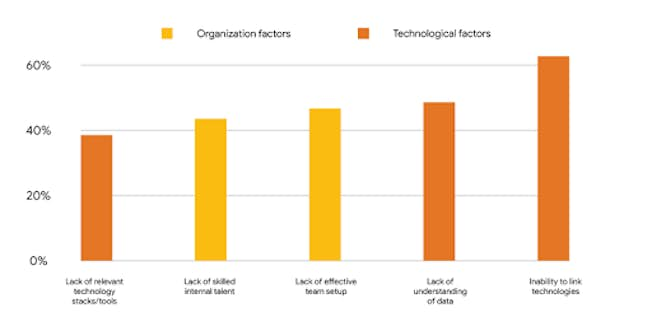Mar 29, 2022
Why First-Party Data is More Important Than Ever and How to Use It
With the demise of third-party cookies to protect user privacy and adhere to regulations such as GDPR, marketers need new ways to capture customer information. This poses a challenge for many organizations that have relied on cookies to not only advertise through digital channels but track user behavior.
For the marketing sector, this is a significant shift from relying on data from external sites in order to advertise and track activities across domains. But this has been coming for several years and the onus is now on marketing teams to find alternatives to deliver personalized content to prospects and customers.
In this blog, we’ll look at how data collection works and explore the best alternative to the norm of third-party data. Welcome to the realm of first-party data - your answer to a cookie-free future in digital marketing.
To help you make the most of your first-party data and understand how to use it to tailor your communications, we’ll cover:
- What is first-party data?
- How is first-party data collected?
- What are the barriers to first-party data collection?
- What can you do with first-party data?
- How to maximize your first-party data collecting
- What’s next for marketers and first-party data?
What is first-party data?
First-party data is information you collect from your audience through your owned digital channels. This makes it reliable and issue-free as people have consented for you to use their data to make contact and engage.

Sources of first-party data include:
- Website or app behavior
- Email and newsletter subscribers
- Lead generation campaigns
- Surveys
- Social media
- Subscriptions
- Customer feedback
- Customer service/sales conversations
- Online chat
Through these channels, you can gain insight and leverage customer and business data. Types of data include demographics, website activity, email engagement, sales interactions, feedback and purchase history along with returns information and stock levels.
What are the benefits of first-party data?
As first-party data is owned by you, and you alone, it offers great insights into your audience. This means that it offers many benefits which include:
- Personalization and integration
- Target the right customers
- Accuracy and control
- Strengthen customer relationships
- Compliance with privacy laws
- Transparency
- Lower cost
It also leaves your competitors in the dark about why you choose to do certain marketing activities or try new tactics. Where previously anyone could access the same data through third-party sources, only you have insight into your customers’ preferences and behaviors.
How is first-party data collected?
There are many ways to collect first-party data. As you see above, there are a variety of channels that users employ to input information.
You can track users across your website/app and social media profiles by adding a pixel about their actions and activities or using a tracking tool like CrazyEgg. This approach tracks what pages people visit, interactions they make, topics they are interested in (for example, what blogs they read). You can also get information such as IP address, preferred language, timestamps, and visited URLs.
All this information should feed into your Customer Relationship Management platform to create a database of anyone that has visited your owned assets. Over time, this will help you build a picture of who that user is so you can target them with relevant information that’s more likely to convert.
You should also think about what first-party data you want to collect at what stage in the customer journey. For example, at the awareness stage, look for data from a subscription or social lead gen form. While at the interest stage, webinars may prove useful in gathering data or looking at purchase behavior to gain insights.
What are the barriers to collecting first-party data?
While there’s huge value in first-party data and a growing importance in collecting and using it, many companies are struggling to unlock its potential.
According to research by Google in the APAC area, there are organizational and technological factors at play that make it difficult. The top reason is an inability to link technologies (which could be due down to many teams still working in remote? silos), while the second is a lack of understanding of data.
On the organizational side, ineffective team set-up and a lack of internal talent are barriers, which could be down to a competition for digital skills in 2022 and a lack of cross-functionality across departments.

Don’t let your company fall prey to these barriers. Ensure your data can be linked and shared across the company and that you have the necessary talent to analyze and use the relevant data in a way that focuses on and enhances customer experience and delivers on ROI.
What can you do with first-party data?
When used correctly, first-party data can be a goldmine for your brand. The demise of third-party cookies may make things harder for marketers, especially for competitive analysis. But the good news is that targeting the right people will get easier as first-party data drives better personalization.
In fact, BCG’s ‘Global Digital Marketing Maturity Survey’ found that companies that link their first-party data sources can generate double the revenue from a single ad, communication, or outreach, and improve cost efficiency by 1.5 times.
Before you start using your data, think about what you want to achieve. Are you looking to build brand awareness, re-engage lapsed customers or drive more leads? By understanding what you’re trying to do, you can use your first-party data effectively.
Here are six effective ways to use your first-party data
- Emails - Segment your audience and create engaging customized emails that are relevant to that group. If you’re struggling to create engaging content, check out our email and copywriting checklist.
- Landing pages - A/B test using customer data on your landing pages to see which message resonates amongst a particular audience.
- Paid ads - Target distinct personas through paid advertising across channels
- Social media - Create tailored content in a variety of formats (e.g. blogs, videos, ebooks) that will speak to your audience segments in organic and paid social posts
- Loyalty programs or membership - Offer early-bird access to sales, discounts or free content (e.g. a relevant eBook)
- Account-based marketing - If you’re a B2B marketer, use this data to create relevant and personalized content and target potential clients across digital channels.
How to maximize your first-party data collection
Now that you know the benefits and uses of first-party data, how are you going to generate it? There are a few simple ways to collect more first-party data that will expand your reach and increase your targeting opportunities:
- Use more lead generation forms - Social media is a good place to start as people are very active across platforms. LinkedIn is a great network for B2B leads, while Facebook and YouTube are very popular amongst audiences on a global scale.
- Re-engage lapsed customers or non-converting prospects - This can be done through a tailored email shot to users on your CRM. You can offer a discount or free download to hook people back in.
- Review and tweak your forms - If you use forms on your website or app or social media, review them to see if you can include questions that get clearer information on a prospect such as job role or company size.
- Experiment with more channels and platforms - There are many great platforms and channels out there to try. Does your company use Reddit or WhatsApp, have you tried advertising on YouTube? Figure out what channels your audience may be active on and try out a campaign.
It should be easy to generate more first-party data by doubling down on the channels you currently use along with trying out new ones.
What’s next for marketers and first-party data?
With third-party cookies on their way out on Google in 2023, there’s no time to waste in planning your first-party approach to increase online revenue.
Integration is crucial as a part of your strategy as you need to collect data that provides insight into your customers and allows you to build a picture of each one so you can target them with personalized messaging. You should also look into zero-party data as a way to get valuable marketing data that’s given willingly by customers.
Marketers today need to improve their customer experience by knowing more about their customers. First-party data could be the answer to that.
Related
Upgrade to Power Membership to continue
your access to thousands of articles, toolkits, podcasts, lessons and much much more.
Become a Power Member- Login
- View Courses
- - - -
- Courses
- Resources
- - - -
- My Account
- Change Password
- Logout





